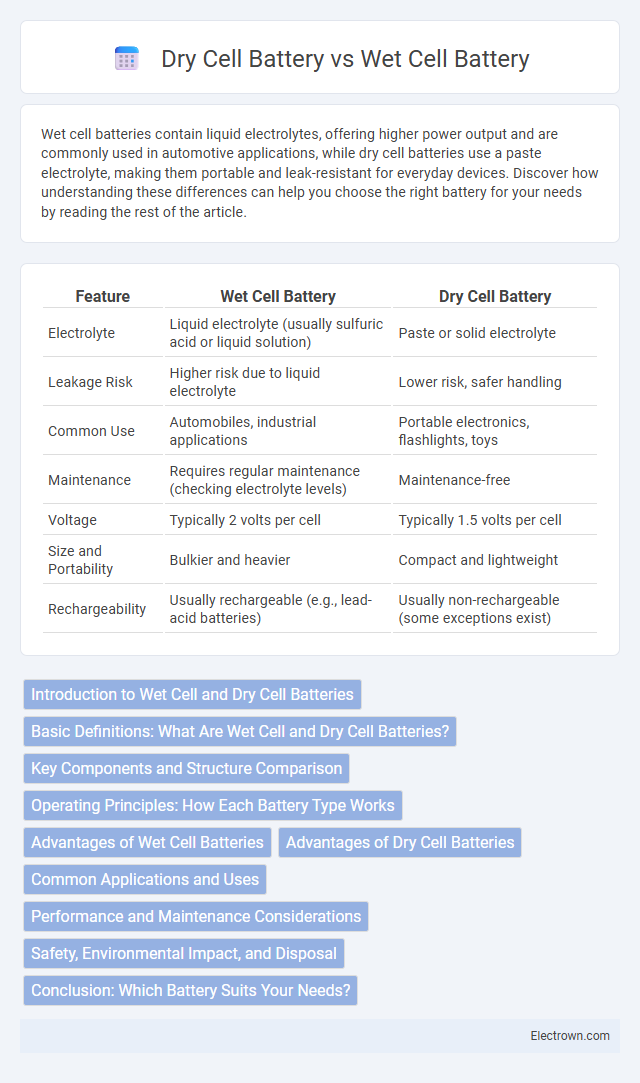Wet cell batteries contain liquid electrolytes, offering higher power output and are commonly used in automotive applications, while dry cell batteries use a paste electrolyte, making them portable and leak-resistant for everyday devices. Discover how understanding these differences can help you choose the right battery for your needs by reading the rest of the article.
Table of Comparison
| Feature | Wet Cell Battery | Dry Cell Battery |
|---|---|---|
| Electrolyte | Liquid electrolyte (usually sulfuric acid or liquid solution) | Paste or solid electrolyte |
| Leakage Risk | Higher risk due to liquid electrolyte | Lower risk, safer handling |
| Common Use | Automobiles, industrial applications | Portable electronics, flashlights, toys |
| Maintenance | Requires regular maintenance (checking electrolyte levels) | Maintenance-free |
| Voltage | Typically 2 volts per cell | Typically 1.5 volts per cell |
| Size and Portability | Bulkier and heavier | Compact and lightweight |
| Rechargeability | Usually rechargeable (e.g., lead-acid batteries) | Usually non-rechargeable (some exceptions exist) |
Introduction to Wet Cell and Dry Cell Batteries
Wet cell batteries use a liquid electrolyte solution to facilitate chemical reactions, making them ideal for applications requiring high power output and easy maintenance, such as car batteries. Dry cell batteries, on the other hand, contain a paste-like electrolyte, offering greater portability and safety for everyday devices like flashlights and remote controls. Understanding the fundamental differences in electrolyte composition helps you choose the right battery type for your specific energy needs.
Basic Definitions: What Are Wet Cell and Dry Cell Batteries?
Wet cell batteries contain a liquid electrolyte that facilitates the flow of ions between the electrodes, commonly found in car batteries and lead-acid systems. Dry cell batteries use a paste or gel electrolyte, making them more portable and leak-resistant, typical in household items like flashlights and remote controls. The primary distinction lies in the electrolyte state, which influences the battery's design, application, and maintenance requirements.
Key Components and Structure Comparison
Wet cell batteries contain a liquid electrolyte, typically sulfuric acid mixed with water, housed in a sealed or vented container, while dry cell batteries use a paste electrolyte sealed within a compact, non-spillable casing. The wet cell structure includes plates made of lead and lead dioxide submerged in the electrolyte, enabling efficient chemical reactions for high current output. Dry cells incorporate zinc and manganese dioxide electrodes separated by the paste electrolyte, providing portability and leak resistance in their compact cylindrical or rectangular forms.
Operating Principles: How Each Battery Type Works
Wet cell batteries operate through a liquid electrolyte solution that facilitates the flow of ions between the electrodes, enabling chemical reactions that generate electrical energy. Dry cell batteries utilize a paste electrolyte, which restricts the movement of liquids, allowing the battery to be more compact and leak-resistant while maintaining ion transfer for current flow. Understanding how each battery type functions can help you make informed decisions about the ideal power source for your needs.
Advantages of Wet Cell Batteries
Wet cell batteries offer higher capacity and longer lifespan compared to dry cell batteries, making them ideal for high-drain applications such as automotive starters and industrial equipment. Their ability to be recharged multiple times enhances cost-effectiveness and sustainability in heavy-duty uses. Wet cells also provide superior performance in cold temperatures due to their liquid electrolyte, ensuring reliable power supply under extreme environmental conditions.
Advantages of Dry Cell Batteries
Dry cell batteries offer several advantages, including their lightweight design and portability, making them ideal for various electronic devices. They have a longer shelf life and lower maintenance requirements compared to wet cell batteries, which contain liquid electrolytes prone to leakage. Your devices benefit from safer, spill-proof operation and greater convenience when using dry cell batteries.
Common Applications and Uses
Wet cell batteries, commonly found in automotive starters, marine applications, and backup power systems, provide high surge currents ideal for heavy-duty uses. Dry cell batteries, widely used in portable electronics, flashlights, and remote controls, offer convenience through their sealed, leak-resistant design. Your choice depends on the power demands and mobility required for the specific application.
Performance and Maintenance Considerations
Wet cell batteries offer higher current output and longer service life in demanding applications but require regular maintenance such as electrolyte level checks and recharging to prevent sulfation. Dry cell batteries provide convenient, spill-proof operation with low maintenance needs, ideal for portable devices but typically have lower capacity and shorter lifespans. Performance depends on usage conditions, where wet cells excel in high-drain and stationary setups, while dry cells suit low-drain and mobile applications.
Safety, Environmental Impact, and Disposal
Wet cell batteries contain liquid electrolytes that pose higher risks of leaks, corrosion, and chemical burns, requiring careful handling to ensure safety. Dry cell batteries use a paste electrolyte, reducing spill risks and environmental hazards, making them safer for everyday use and easier to transport. Proper disposal of wet cells demands neutralizing hazardous liquids, while dry cells are generally safer to recycle; always follow local guidelines to minimize environmental impact and protect Your health.
Conclusion: Which Battery Suits Your Needs?
Wet cell batteries provide higher capacity and are ideal for applications requiring sustained power and frequent recharging, such as automotive starters and backup systems. Dry cell batteries offer portability, leak resistance, and convenience, making them suitable for everyday electronics like remote controls and flashlights. Choosing between wet and dry cells depends on your specific power demands, usage environment, and maintenance preferences.
Wet cell vs Dry cell battery Infographic

 electrown.com
electrown.com